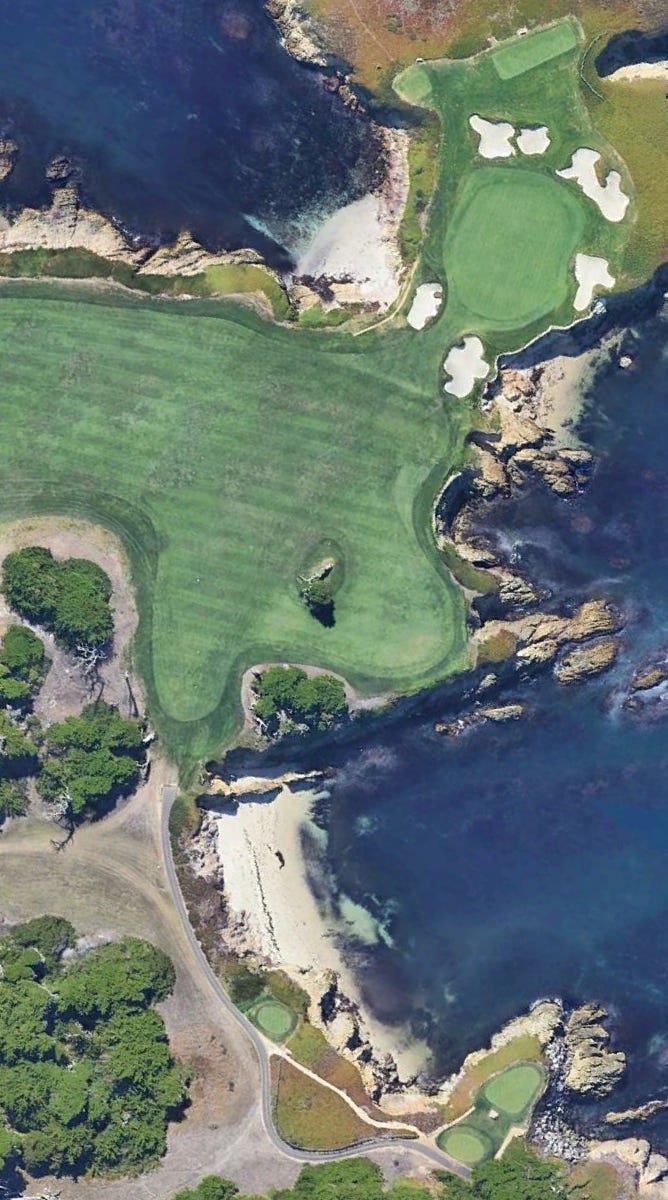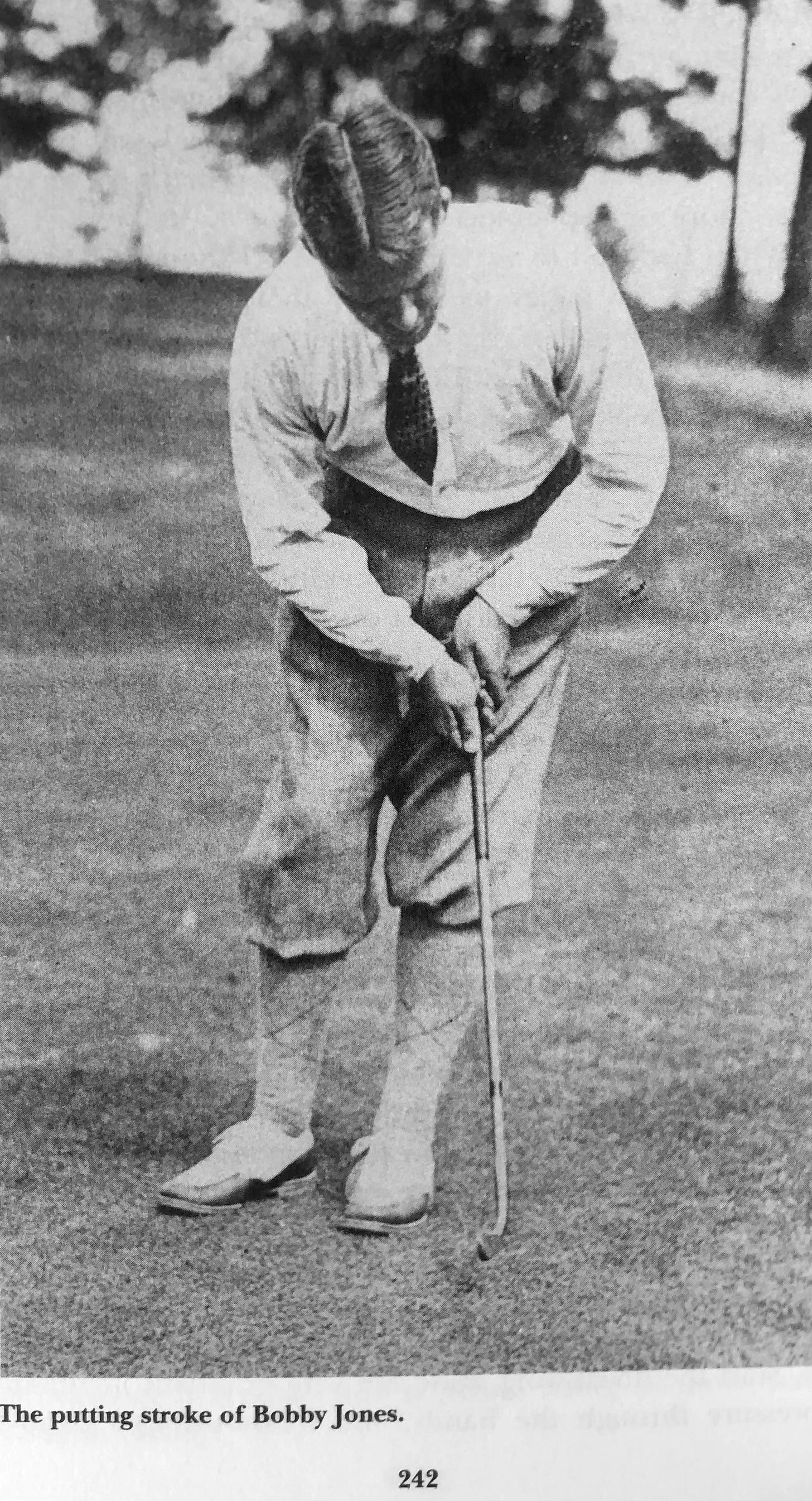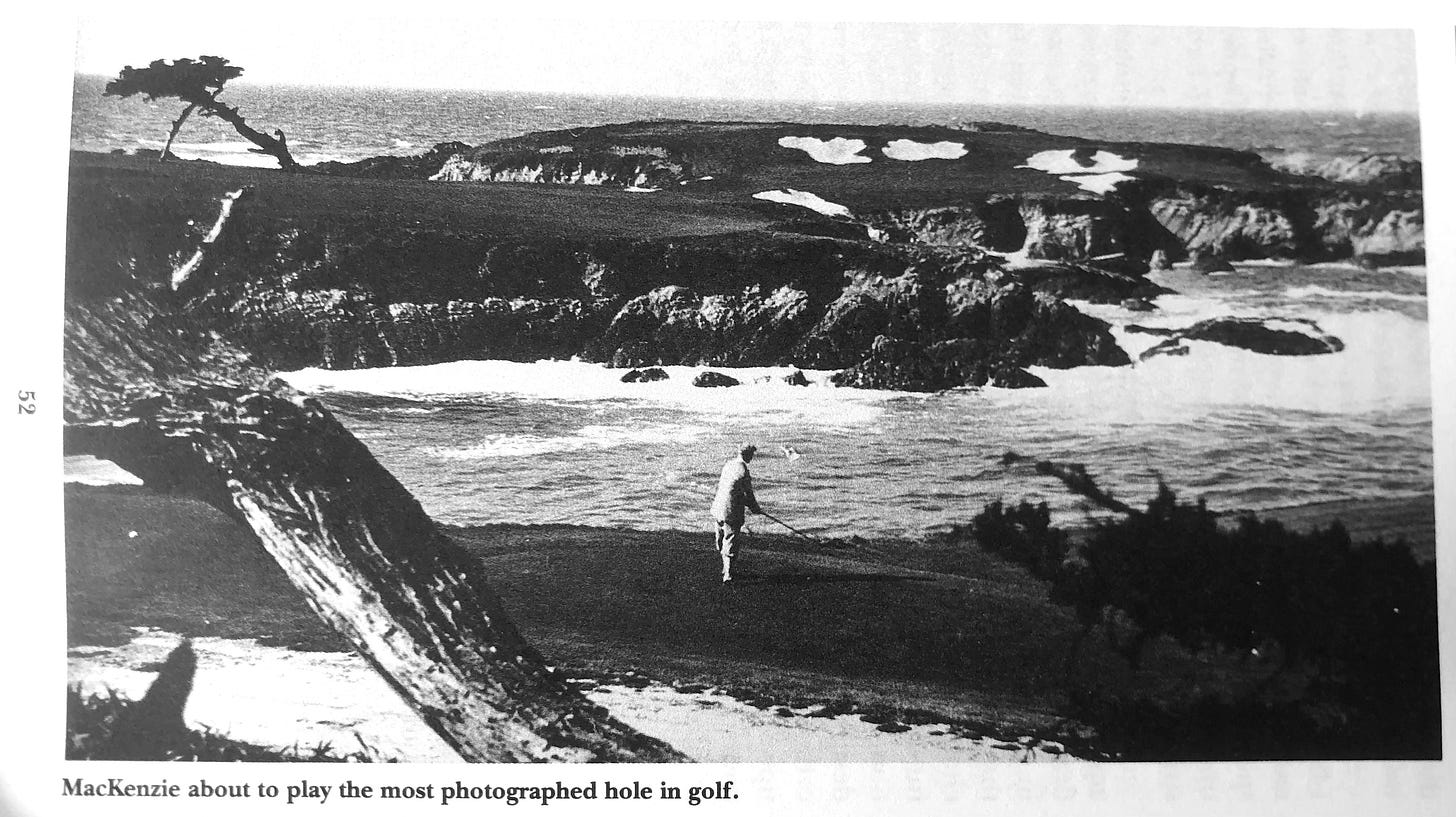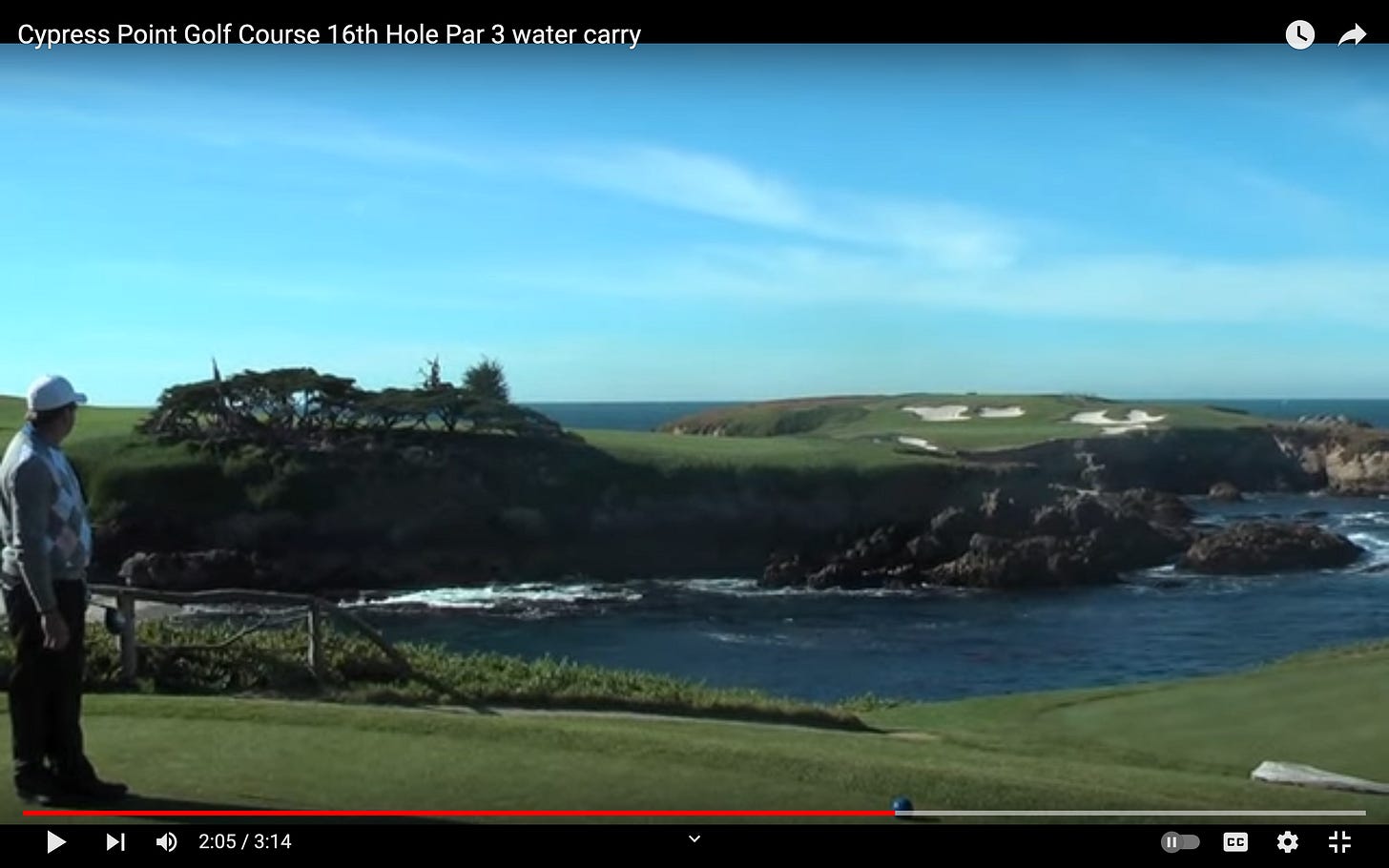The 16th at Cypress Point With a Putter
A deep dive into MacKenzie's tall tale and what it can tell us about his views on architecture
In The Spirit of St. Andrews, Alister MacKenzie discusses ideal holes and turns to #16 at Cypress Point where he cites an anecdote:
I was traveling from San Francisco to New York with a man who is affectionately know as Billy Humphrey. He said, “What sort of hole do you think your 16th at Cypress Point is? I don’t think a hole is a golf hole that can be played with a putter.” “On the contrary,” I said, “I don’t think and ideal hole is ideal unless it can be played with a putter, but we won’t argue about that. What is your trouble?” He said, “Well, I was playing this hole against Herbert Fleischaker for two hundred dollars. [Herbert Fleischaker has a reputation of not being able to get a ball off the ground, but he is full of brains, is a very good approacher and putter, and often outwits a more powerful opponent.] It was my honour, and I put two shots in the ocean. Then old Herbert gets his putter, takes four putts to reach the green, wins the hole and two hundred dollars.” I am afraid I was not unduly sympathetic.1
Now, the anecdote comes at the end of the section discussing the hole, but MacKenzie seems to introduce the story as a way to reiterate that, for him, a hole must provide routes to the green for weaker players. However, as the 16th at Cypress Point is almost entirely a carry over water and the story, on its face, seems absurd. So much so, that some have voiced their doubts, suggesting it is more myth than truth.2 This doubt seems reasonable, as this is likely the most spectacular hole MacKenzie ever created and he may wish to include it in any list of ideal holes. After some research, though, I want to argue here that it’s not only possible that the story is true, I’d argue that it’s plausible.
The most complicating factor is that MacKenzie’s manuscript, finished in 1933, was only published as The Spirit of St. Andrews in 1995. So many of the obvious ways to check the story are lost. The most straightforward way to verify the story would be to confirm it with one of the players. Herbert Fleischaker was a prominent businessman in San Francisco, and had the book been published in a timely manner, either he or Billy Humphrey could have easily confirmed or denied the story.34
Now, I venture that most say that using a putter on the hole is impossible, or at least improbable, because they are thinking in terms of modern putters and the current hole layout. Putters at during the period discussed have much more loft and a different club face than putters have had since the mid-century. While modern putters only have a couple degrees of loft. We can see from MacKenzie’s text that putters during this time more closely resembled a four iron. Here we see Bobby Jones with his putter:5
While shorter than an iron, MacKenzie notes that players regularly hit these significantly farther than we do today:
Indeed on golf courses like St. Andrews in Scotland there is no margin, and players frequently use their putters up to fifty yards, or more, away from the hole.6
Next, when looking at the difference in layout between the time of writing and modern day, we can see that this might affect what we may think is possible. We can see the hole from MacKenzie’s time in the book:
The photograph on page 52 gives a good idea of the character of the hole. There are three alternative routes, namely, the direct route over 200 yards of ocean to the green, an intermediate route over about 100 yards of ocean, and a still shorter route to the left.7
Compare that image with a modern image of someone playing from the same tee:8
The most relevant thing we see here is the invasive ice plant.9 We can see that this ice plant is a modern addition, as it doesn’t exist in historic aerial photography:
In 1939, the area left of the tees appears to be similar turf as the fairways themselves, if not a bit dryer, as is area left in modern photos. And, we can also see that there is no fencing in the earlier layout of the hole. The large section of ice plant would not interfere with someone attempting to round the cliff.
If one were to play out left what would the minimum carry even be? Well, MacKenzie notes this in another essay published in The Fairway the same year the course opened:
It shares with the old course at St. Andrews the distinction of being just as pleasurable to the dub as the scratch man — at no place is there a compulsory carry of more than 80 yards, but many holes there are voluntary carries of 200 to 250 yards tempting the long drivers to great rewards.10
Here we know that, at most, a compulsory carry could only be 80 yards, which is significantly less than we would imagine on this hole. This distance, played with what is effectively a shortened modern four iron, starts to seem a lot more plausible.
Now, suppose that Fleischaker didn’t even attempt that shorter carry, I still would argue that the four-putt to the green is possible given what we know. From the same video as earlier, we see that land above the cliff favors a player trying to round the corner that way:
There is a reasonable margin of safety playing out that way. And, given the lack of ice plant to interfere with a low, running shot, we can see that four 75-yard putts using the contour of the cliff should be able to reach the front edge of the green without any carry whatsoever:
Now, these would be very long putts, but if they have the loft of a four iron, they would be more likely to run than roll like a putt to reach these distances. Still, given that MacKenzie noted that players of his day regularly could putt 50 yards or more, I think a few 75-yard putts stops being ridiculous, and starts seeming surprisingly practical, especially for a player in exactly this position. Remembering that MacKenzie notes that Fleischaker “is a very good approacher and putter.” A player who can expertly place running shots should be able to navigate the contours of the cliff and the narrow gap between the fronting bunkers. I think there is little reason to doubt the story beyond simple contrarianism.
At this point, however, I feel that the real moral of the story may be more nuanced than originally stated. While he states initially that this is about “a sufficiently easy route for weaker players,” I suspect that the reason for MacKenzie’s rule about the putter is simply his great appreciation of the ground game.11 He seems to hold players who run the ball in great admiration, especially when they use contours to guide the ball to challenging pin positions.12 It would make sense that he would always want to allow players to run the ball through the contours, and he only pushed back in the anecdote because Humphrey insisted that any ideal golf hole must only be one that rewards the aerial game.
We now have many holes designed with modern putters as an option13 These holes are excellent, no doubt, and perhaps designed as a nod to MacKenzie’s maxim. I worry though, that if my suspicion is correct, then his rule is now being misapplied. Though the difference between a four iron and putter is marginal, I think a design moral about contouring and the ground game might be missed. Obviously further research is needed, but I think it’s something worth noting—at least for now—as a possibility. At the end of the day, I think it’s a fun story and is one that is entirely plausible as far as I’m concerned.
MacKenzie, Alister. The Spirit of St. Andrews. Wiley, 1995. 136.
Doubt has been cast by folks in the golf course architecture community. Notably by folks who have had the opportunity to play the hole. An important aspect to understand here is that Cypress Point is one of those courses that is effectively impossible to play. Thus, it can be challenging to counter folks who have experience there, as there is no practical way to confirm or deny claims about the course.
The following is a relevant skeptical thread from Golf Club Atlas, a forum that caters to folks who work in the industry and thus have access to courses that would otherwise be inaccessible: https://www.golfclubatlas.com/forum/index.php/topic,46219.msg1020268.html#msg1020268
“Herbert Fleishhacker.” Wikipedia, https://en.wikipedia.org/wiki/Herbert_Fleishhacker. Accessed 1 October 2023.
The other person noted is called Billy Humphrey “affectionately.” This likely means that this is not his given name. I was not as quickly able to identify him, but here I will try to share my thoughts on who this could be. Obviously, if the identity is already known, please leave me a comment.
So, what do we know about Humphrey from this story:
We know Humphrey was the type of man who would be willing to gamble about $4,000 on a single hole of golf. Since the wager is set at $200, we can try and establish it’s value within the time frame of when the story could have happened. MacKenzie notes that the story was told to him “a few months ago,” but it is unclear when this events in the story happened. Since the course opened in 1928 and the manuscript was completed in 1933, we have an idea of the stakes involved. Using a simple inflation calculator, we see that the wager was somewhere between $3,590.95 (1928 dollars) and $4,723.48 (1933 dollars). Note the deflation here. The course opened on August 11, 1928. The Stock Market crashes October 29, 1929, leaving just over a year for this event to have happened before the crash, which will be relevant to some of the folks “Billy Humphrey” could be.
We know Humphrey had a reason to be in New York, as he was traveling from San Francisco to New York. Being in San Francisco could easily be related to traveling to-and-from Cypress Point (though this is not specifically stated), because, though the Bay Bridge is not finished until 1936 the author likely refers to San Francisco more generally, even if a ferry was needed to reach the train.
Finally, we know the Billy Humphrey needs to be the type of person that would be invited to, or be a member of Cypress Point Club, which, due to the history of racial exclusion, almost certainly omits the possibility of Willie Humphrey, noted jazz clarinetist from New Orleans.
Also, note that Herbert Fleishacker would have been between 56 and 61, and Alister MacKenzie would have been between 58 and 63 at the time.
This leads me to speculate that “Billy Humphrey” refers to one of the following individuals:
William J. Humphrey would have been between 53 and 58 during the possible dates. He was a prominent silent film actor at the time, lived in Hollywood, and was from Massachusetts, so could have easily had connections in New York, if not business there.
William E. Humphrey would be an incredibly good guess were it not for his age. He was a former member of the House of Representatives (from the State of Washington) and former member of the Federal Trade Commission. However, he would have been between the age of 66 and 71 (the age he died). The idea that a person in their late 60s can make the 200 yard carry onto this green is slim, however, what if the bitterness in the story comes from the fact that the congressman put two in the ocean while only playing to the layup position? Suddenly we would have an strong reason for his strong opinion.
Finally, there is Lord William Humphrey a noted falconer and dog breeder, who I’m mainly including in the story because we know he spent a good amount of time in New York, holds a royal title (though it is dubious whether the title was given to him during the time frame needed), and that dog breeding and falconry seems like the type of thing that folks at an exclusive club would have been into. While the citation says that he left America after a stock market crash, we don’t know which it was, and there is still a window where the event could have occurred, even if this is challenged by the date of the meeting on the train.
Again, if the identity of Billy Humphrey is known. Please let me know.
MacKenzie (1995) 242.
MacKenzie (1995) 258.
MacKenzie (1995) 135-136
gat1967. “Cypress Point Golf Course 16th Hole Par 3 water carry.” YouTube, 29 January 2011,
Accessed 1 October 2023.
“Carpobrotus edulis.” Wikipedia, https://en.wikipedia.org/wiki/Carpobrotus_edulis. Accessed 1 October 2023.
MacKenzie, Alister. “Cypress Point Golf Course: Has Similar Strategic Problems to St. Andrews and Is Infinitely More Spectacular and Beautiful.” The MacKenzie Reader, Edited by Joshua Pettit, The Alister MacKenzie Institute, 2020, pp. 81-91. Originally published in The Fairway, San Francisco, Nov 1928.
MacKenzie (1995) 137.
He notably discusses this in The Spirit of St Andrews in the section on the 16th at St Andrews, Corner of the Dyke (pages 139-142). He references a Ted Blackwell who uses a small valley contour to run the ball up to the most difficult pin position. The admiration is such that MacKenzie states:
Is there any course in the world that presents such subtle strategic problems? There are thousands of golfers who have played St. Andrews for years and have failed to solve them or even see them. Ted Blackwell has played St. Andrews fifty years and it map have been thirty years before experience taught him how to play this particular hole.
(MacKenzie (1995) 142). Note that MacKenzie’s praise of players who use the run-up is not reserved to just this reference.
Hooked on Golf Blog. “Bandon Preserve 13th - Putter off the Tee.” YouTube, 24 June 2019,
Accessed 2 October 2023.








